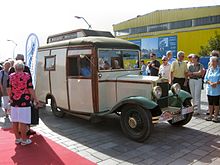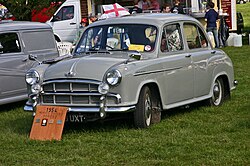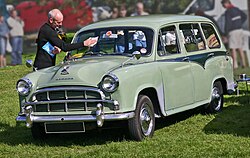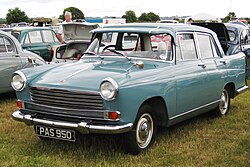Morris Oxford
| Morris Oxford | |
|---|---|
| Production period: | 1913-1915 1919-1935 1948-1971 |
| Class : | Middle class |
| Body versions : | Touring car , sedan , station wagon , coupé |
| Successor: |
Morris Fourteen Morris Sixteen Morris Eighteen Morris Marina |
The Morris Oxford name was used by the Morris Motor Company for a number of car models, from the 1913 Bullnose model to the Morris Oxford Series VI, which was discontinued in 1971.
Oxford (Bullnose) (1913-1915)
| Oxford (Bullnose) (1913-1915) | |
|---|---|
|
Morris Oxford (1913-1915) |
|
| Production period: | 1913-1915 |
| Body versions : | Touring car |
| Engines: |
Otto engine : 1.0 liter (11 kW) |
| Length: | 3200-3581 mm |
| Width: | |
| Height: | |
| Wheelbase : | 2134-2286 mm |
| Empty weight : | 610 kg |
William Morris' first car was named after his hometown Morris Oxford . It was a small car with a side-controlled 4-cylinder engine with 1018 cm³ displacement, 15 bhp (11 kW) power, and a fixed cylinder head. It was supplied by White & Poppe . The ignition works with a Bosch magnet.
The chassis was a pressed steel construction; the front wheels were suspended from semi-elliptical leaf springs, the rear wheels from 3/4 elliptical leaf springs. The brakes (only on the rear wheels) were external shoe brakes. A gearbox with 3 forward gears and one reverse gear was installed. The headlights were operated with acetylene , the position lights and taillights with lamp oil.
The vehicle got the name "Bullnose" because of its rounded radiator. Most of the bodies were 2-seat tourers.
Oxford (1919-1926)
| Oxford (1919-1926) | |
|---|---|
|
Morris Oxford (1922) |
|
| Production period: | 1919-1926 |
| Body versions : | Touring car , limousine |
| Engines: |
Petrol engines : 1.55–2.3 liters (18–29 kW) |
| Length: | 3708-3962 mm |
| Width: | |
| Height: | |
| Wheelbase : | 2591-2819 mm |
| Empty weight : | |
The 1919 Morris Oxford was a luxury version of the Morris Cowley . It had a similar cooler to the pre-war "Bullnose" model, but a little bigger. The 1548 cm³ engine was manufactured for Morris by the British branch of the French company Hotchkiss et Cie in Coventry, and it was much cheaper than White & Poppe. (Morris bought the British subsidiary in 1923 and changed the name to "Morris Motorenbau".) In 1923 the displacement was increased to 1802 cm³.
The Oxford differed from the Cowley model in that it had better electrical systems and leather upholstery. In 1925 it got a longer chassis and four-wheel brakes to differentiate it more from the Cowley. This Oxford model became the basis for the first MG , the 14/28 Super Sports. The closed bodies were primarily supplied by Chalmer & Hoyer in the 1920s .
A short-lived 6-cylinder variant, the Morris Oxford Six (F-Type) was announced in 1920 and was theoretically available until 1926. The engine with 2320/2355 cc and 39 bhp (29 kW) turned out to be unreliable and so few cars were sold. Although the car was 230 mm longer than the four-cylinder, all of the additional space was not available for the passengers, only for the engine.
Oxford (Flatnose) (1926-1930) and Six (1929-1933)
| Oxford (1926-1933) | |
|---|---|
|
Morris Oxford Saloon (1931) |
|
| Production period: | 1926-1933 |
| Body versions : | Touring car , limousine , coupé |
| Engines: |
Gasoline engines : 1.9–2.5 liters |
| Length: | |
| Width: | |
| Height: | |
| Wheelbase : | 2896 mm |
| Empty weight : | |

The eye-catching "bullnose" radiator was phased out in 1926 when a revised version of the car came out. The engine range remained the same, but there were several new bodies, including an all-steel sedan.
A 6-cylinder version with 1938 cc, the Morris Oxford 6 Series LA was produced from 1929 to 1933 and was much more successful than the 1920 version. In addition to the tourer, an all-steel sedan and a canvas-bodied car were offered until 1932. At this point the tourer and canvas body were discontinued and a coupe was introduced.
From 1932 the transmission was given a 4th gear and the displacement of the Morris Oxford 6 Series Q grew to 2062 cm³.
Oxford Sixteen & Twenty (1934-1935)
| Oxford 16 (1934-1935) Oxford 20 (1935) |
|
|---|---|
|
Morris Oxford 16 (1934) |
|
| Production period: | 1926-1933 |
| Body versions : | Touring car , limousine |
| Engines: |
Petrol engines : 2.1–2.6 liters |
| Length: | 4242 mm |
| Width: | 1778 mm |
| Height: | |
| Wheelbase : | 2896 mm |
| Empty weight : | |
A completely new car was announced for 1934. It had a stronger chassis with a softer suspension for the 2062 cm³ engine. The transmission received a synchronization. Initially the car kept the name Oxford 6, but from 1935 on it was called the Morris Oxford 16 and the Morris Oxford 20 was added to it.
In 1935 it was replaced by the Morris Fourteen , the Morris Sixteen and the Morris Eighteen . The name "Oxford" disappeared until 1948.
Oxford MO (1948-1954)
| Oxford MO (1948-1954) | |
|---|---|
|
Morris Oxford MO (1950) |
|
| Production period: | 1948-1954 |
| Body versions : | Limousine , station wagon |
| Engines: |
Otto engine : 1.5 liters (30 kW) |
| Length: | 4204 mm |
| Width: | 1651 mm |
| Height: | |
| Wheelbase : | 2464 mm |
| Empty weight : | 1003 kg |
After the Second World War , the Morris Oxford MO became the successor to the Morris Ten . It was produced from 1948 to 1954. The Wolseley 4/50 was also delivered with the same body .
Morris introduced the self-supporting body with the Oxford MO and the similarly constructed Morris Minor . Both were designed by Alec Issigonis . In many cases it is not viewed as a real self-supporting structure. The torsion bar suspension was another innovation, and all 4 wheels were fitted with brake drums with a diameter of 200 mm. The drive, however, was a step backwards compared to the pre-war model Ten : the four-cylinder in-line engine was side-controlled, so it did not have overhead valves like the engine of the previous model. With a displacement of 1476 cm³ and an output of 40.5 bhp (30 kW), it accelerated the car up to 116 km / h. It had a 4-speed gearbox with a steering wheel gearshift and worm steering.
The MO was offered as a 4-door sedan and a 3-door station wagon, each with 4 seats. In 1954 he was replaced by the Oxford Series II.
A 6 cylinder version was sold as the Morris Six MS / Wolseley 6/80.
Oxford Series II (1954-1956)
| Oxford Series II (1954-1956) | |
|---|---|
|
Morris Oxford Series II |
|
| Production period: | 1954-1956 |
| Body versions : | Limousine , station wagon |
| Engines: |
Otto engine : 1.5 liters (37 kW) |
| Length: | 4343 mm |
| Width: | 1651 mm |
| Height: | 1600 mm |
| Wheelbase : | 2464 mm |
| Empty weight : | 1080 kg |
After the merger of Austin and Morris to form the British Motor Corporation , the Oxford got the four-cylinder in-line B-series engine that Austin had designed. The modern machine with a displacement of 1489 cm³ developed 50 bhp (37 kW) and gave the Morris Oxford a top speed of 119 km / h. There were still drum brakes on all 4 wheels, but with a drum diameter of 230 mm.
The vehicle now looked less like the Morris Minor, but the family resemblance of the round body was still visible. There were again two 4-seater, a 4-door sedan and a 3-door station wagon. The cars sold well and in 1956 the III appeared. Series.
There was also a version with a six-cylinder engine, the Morris Isis .
Oxford Series III (1956-1959)
| Oxford Series III (1956-1959) | |
|---|---|
|
Morris Oxford Series III (1956-1959) |
|
| Production period: | 1956-1959 |
| Body versions : | Limousine , station wagon |
| Engines: |
Otto engine : 1.5 liters (40 kW) |
| Length: | 4343 mm |
| Width: | 1651 mm |
| Height: | 1600 mm |
| Wheelbase : | 2464 mm |
| Empty weight : | 1080 kg |
In 1956 the Oxford was redesigned and got two-tone paintwork and a body with tail fins. The machine now delivered 55 bhp (40 kW), but top speed and acceleration remained the same. There was an optional automatic transmission. The Series III - "Woody" station wagon was replaced by that of the IV series in 1957; the sedan remained in production until the introduction of the V series model designed by Pininfarina in 1959. A total of 58,117 III. and IV. series produced.
This car was the base for the Hindustan Ambassador , which was built in India until May 2014 .
Oxford Series IV (1957-1960)
| Oxford Series IV (1956-1959) | |
|---|---|
|
Morris Oxford Series IV |
|
| Production period: | 1957-1960 |
| Body versions : | Station wagon |
| Engines: |
Otto engine : 1.5 liters (40 kW) |
| Length: | 4331 mm |
| Width: | 1651 mm |
| Height: | 1600 mm |
| Wheelbase : | 2464 mm |
| Empty weight : | 1194 kg |
The Morris Oxford Series IV was only available as a station wagon. The all-steel variant replaced the "Woody" of the III. Series, but was similar in styling. It was introduced in 1957 and was manufactured together with the Series V Oxford until 1960.
Oxford Series V (1959-1961)
| Oxford Series V (1959–1961) ( ADO9 ) | |
|---|---|
|
Morris Oxford Series V (1959) |
|
| Production period: | 1959-1961 |
| Body versions : | Limousine , station wagon |
| Engines: |
Otto engine : 1.5 liters (40 kW) |
| Length: | 4458 mm |
| Width: | 1613 mm |
| Height: | 1520 mm |
| Wheelbase : | 2527 mm |
| Empty weight : | 1093 kg |
In 1959, the bodies of all medium-sized cars from the BMC Group were standardized as part of the ADO9 project . All cars received the same body designed by Pininfarina, apart from the Morris Oxford, the Wolseley 15/60 from 1958, the Riley 4/68 from 1959, the Austin A55 Cambridge and the MG Magnette Mark III . Austin and Morris vehicles were almost identical, but were manufactured in different locations. The differences between the Morris and the Austin were larger tail fins and different taillights. Inside, a bench and a special dashboard were installed. The 1.5 l machine of the B series was built and the station wagon of the IV series was still sold in the first year. There was also a Series V station wagon. A total of 87,432 Series V Oxfords were made.
Oxford Series VI and Series VID (1961–1971)
| Oxford Series VI (1961–1971) ( ADO38 ) | |
|---|---|
|
Morris Oxford Series VI (1964) |
|
| Production period: | 1961-1971 |
| Body versions : | Limousine , station wagon |
| Engines: |
Otto engine : 1.6 liters (45 kW) Diesel engine : 1.5 liters (29 kW) |
| Length: | 4432 mm |
| Width: | 1613 mm |
| Height: | 1520 mm |
| Wheelbase : | 2546 mm |
| Empty weight : | 1093-1118 kg |
All five cars designed by Pininfarina were redesigned in 1961. There was a new B-series engine with 1622 cc and a new look. The Austin and Morris products had trimmed tail fins of different shapes (those of the Austin were more rounded). The Morris dashboard stayed the same, while the Austin got one made of imitation wood. A version with a diesel engine (1489 cm³, 40 bhp / 29 kW) was popular as a taxi.
The Morris automobiles remained in production until 1971; 208,823 units were built. The Oxford series was replaced by the Morris Marina .
Web links
swell
- Culshaw, David & Horrobin, Peter: The Complete Catalog of British Cars 1895-1975 , Veloce Publishing PLC, Dorchester (1997), ISBN 1874105936 .
Individual evidence
- ^ A b c d N. Baldwin: AZ of cars of the 1920's . Bay View Books, 1994, ISBN 1-870979-53-2 .
- ^ A b M. Sedgwick and Gillies: AZ of cars of the 1930's . Bay View Books, 1989, ISBN 1-870979-38-9 .












